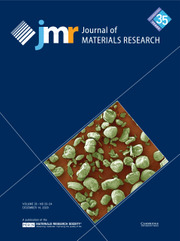Article contents
In situ transformation behavior of icosahedral and decagonal quasicrystalline phases
Published online by Cambridge University Press: 31 January 2011
Abstract
Results of in situ hot-stage electron microscopic investigations on the transformation behavior of icosahedral Mg32 (Al,Zn)49 and decagonal Al–Co quasicrystalline phases are presented. It is shown that in both the cases the transformation begins with the formation of fine holes. This has been interpreted on the basis of the lower density of the quasicrystalline phase. Differences in the transformation behavior between the icosahedral and decagonal phases are highlighted.
- Type
- Articles
- Information
- Copyright
- Copyright © Materials Research Society 1988
References
REFERENCES
1Gratias, D. and Michel, L. editors, J. Phys. (Paris), Suppl. 7, 47, Colloq. 3 (1986).Google Scholar
4Chattopadhyay, K.Ranganathan, S.Subbanna, G. N. and Than-garaj, N., Scr. Metall. 19, 767 (1985).Google Scholar
6Samuel, F. H.Samuel, A. M.Jonckere, A. de, and Gerin, F.Metall. Trans. A17, 1671 (1986).Google Scholar
7Quan, M. X. and Giessen, B. C. in Rapidly Solidified Alloys and Their Mechanical and Magnetic Properties, edited by Giessen, B. C.Polk, D. E. and Taub, A. I. (Materials Research Society, Pittsburgh, PA, 1986), p. 237.Google Scholar
8Urban, K.Mayer, J.Rapp, M.Wilkens, M.Csanady, A. and Fidler, J.J. Phys. (Paris) 47, C3–465 (1986).CrossRefGoogle Scholar
13Chandra, Subash, Tech, M.. (Met. Eng.) dissertation, Banaras Hindu University, Varanasi, India, 1987.Google Scholar
17Wiedersich, H. in Radiation Damage in Metals, edited by Peterson, N. L. and Harkness, S. D. (American Society for Metals, Metals Park, OH, 1976), p. 157.Google Scholar
- 8
- Cited by


